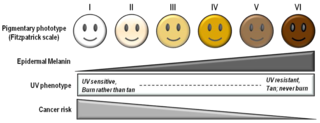Fitzpatrick scale

The Fitzpatrick scale (also Fitzpatrick skin typing test; or Fitzpatrick phototyping scale) is a numerical classification schema for
The following table shows the six categories of the Fitzpatrick scale in relation to the 36 categories of the older von Luschan scale:[6][7][8]
| Fitzpatrick type | von Luschan scale | Characteristics |
|---|---|---|
| I | 0–6 | always burns, never tans (palest; freckles )
|
| II | 7–13 | usually burns, tans minimally (light colored but darker than fair) |
| III | 14–20 | sometimes mild burn, tans uniformly (golden honey or olive) |
| IV | 21–27 | burns minimally, always tans well (moderate brown) |
| V | 28–34 | very rarely burns, tans very easily (dark brown) |
| VI | 35–36 | never burns (deeply pigmented dark brown to darkest brown) |
Emoji modifiers
The Fitzpatrick scale is also the basis of skin color in emoji, with five modifiers according to the Fitzpatrick scale (types I and II merged).
Eurocentric bias
The Fitzpatrick scale has been criticized for its Eurocentric bias and insufficient representation of global skin color diversity.[9] The scale originally was developed for classifying "white skin" in response to solar radiation,[2] and initially included only four categories focused on white skin, with "brown" and "black" skin types (V and VI) added as an afterthought.[3]
The scale's methodology, relying on self-reporting of skin color, sunburn, and sun tanning response, fails to capture the broad spectrum of skin reflectance. Studies demonstrate that European populations have the narrowest skin color variation, whereas groups categorized as 'brown' or 'black' exhibit a much wider range.[10][11]
The efficacy of the Fitzpatrick scale even among white-skinned individuals has been argued to be questionable,[9] since studies such as that on a Dutch student population[12] have found it inadequate for categorizing, challenging its appropriateness for investigating the relationship between sunburn tendency and tanning ability.[9]
The Fitzpatrick scale's Eurocentric orientation and its limitations in accurately representing global skin color diversity, along with similar biases in classifying other phenotypic traits, have been argued to require more inclusive and scientifically valid categorizations in dermatological and genetic research.[9]
See also
- Monk Skin Tone Scale
- von Luschan's chromatic scale
- Skin reflectance
- Brown Paper Bag Test
References
- PMID 23749111.
- ^ a b Fitzpatrick, T. B. (1975). "Soleil et peau" [Sun and skin]. Journal de Médecine Esthétique (in French) (2): 33–34
- ^ PMID 3377516
- ^ Pathak, M. A.; Jimbow, K.; Szabo, G.; Fitzpatrick, T. B. (1976). "Sunlight and melanin pigmentation". In Smith, K. C. (ed.): Photochemical and photobiological reviews, Plenum Press, New York. pp. 211–39[ISBN missing]
- ^ Fitzpatrick, T. B. (1986). "Ultraviolet-induced pigmentary changes: Benefits and hazards", Therapeutic Photomedicine, Karger, vol. 15 of "Current Problems in Dermatology", pp. 25–38
- ^ "The Fitzpatrick Skin Type Classification Scale". Skin Inc. (November 2007). 13 May 2008. Retrieved 7 January 2014.
- ^ "Fitzpatrick Skin Type" (PDF). Australian Radiation Protection and Nuclear Safety Agency. Retrieved 30 November 2017.
- ^ "What Is Golden Skin Tone? (With Pictures)". 9 March 2020.
- ^ PMID 33675042.
- PMID 29025994.
- PMID 29195075.
- PMID 3377517.
